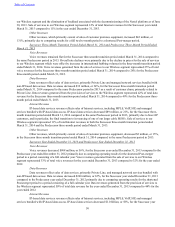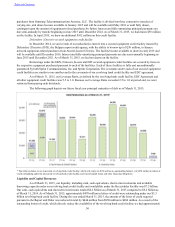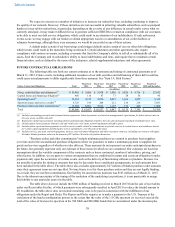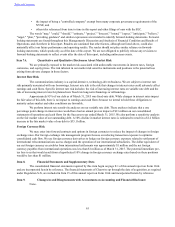Sprint - Nextel 2014 Annual Report Download - page 62
Download and view the complete annual report
Please find page 62 of the 2014 Sprint - Nextel annual report below. You can navigate through the pages in the report by either clicking on the pages listed below, or by using the keyword search tool below to find specific information within the annual report.
Table of Contents
60
Leased Devices
Our accounting for device leases involves specific determinations under applicable lease accounting standards.
These determinations affect the timing of revenue recognition and the timing and classification of the related cost of the
device. If a lease is classified as an operating lease, revenue is recognized ratably over the lease term and the leased asset is
included in property, plant and equipment and depreciated over the term of the lease. If the lease is classified as a sales-type
lease, equipment revenue is recognized at the inception of the lease with a corresponding charge to cost of product. If the
lease is classified as s direct-financing lease, there is no related revenue of cost of products recorded and the net investment in
a leased asset is reported. The critical elements that we consider in determining the classification of our leased devices are the
economic life and the fair value of the device, including the residual value. For the purposes of assessing the economic life of
a device, we consider both internal and external datasets including, but not limited to, the length of time subscribers use our
handsets, sales trends post launch, and transactions in the secondary market as there is currently a significant after-market for
used telecommunication devices.
As of March 31, 2015, substantially all of our device leases were classified as operating leases. At lease inception,
the devices leased through Sprint's direct channels are reclassified from inventory to property, plant and equipment. For those
devices leased through indirect channels, Sprint will purchase the device to be leased from the retailer at lease inception. The
devices are then depreciated to their estimated residual value. Residual values associated with devices under operating leases
represent the recorded estimated fair value at the end of the lease term. We review residual values regularly and, when
appropriate, adjust them based on, among other things, estimates of expected market conditions at the end of the lease,
including the impacts of future product launches. Adjustments to residual values of leased devices are recognized as a
revision in depreciation estimates. We estimate that a 10% increase or decrease in the estimated residual values of devices
currently under operating leases at March 31, 2015 would not have a material effect on depreciation expense over the next
twelve months.
Valuation and Recoverability of Long-lived Assets
Long-lived assets are reviewed for impairment whenever events or changes in circumstances indicate that the
carrying amount may not be recoverable. An impairment loss is recognized if the carrying amount of a long-lived asset or
asset group is not recoverable and exceeds its fair value. Long-lived asset groups have been determined based upon certain
factors including assessing the lowest level for which identifiable cash flows are largely independent of the cash flows of
other groups of assets and liabilities. Impairment analyses, when performed, are based on our current business and
technology strategy, views of growth rates for our business, anticipated future economic and regulatory conditions and
expected technological availability.
During the quarter ended December 31, 2014, we tested the recoverability of the Wireline long-lived assets due to
continued declines in our Wireline segment earnings and our forecast that projected continued losses in future periods. As a
result of the test, we recorded an impairment loss of $233 million, which is included in “Impairments” in our consolidated
statements of operations, to reduce the carrying value of the Wireline asset group, which includes the Wireline long-lived
assets, to its estimated fair value of $918 million as of our testing date. The fair value of the Wireline long-lived assets was
estimated using a market approach, which included significant unobservable inputs including liquidation curves, useful life
assumptions, and scrap values. As the assumptions are largely unobservable, the estimate of fair value is considered to be
unobservable within the fair value hierarchy.
The determination of fair value requires judgment and is sensitive to changes in underlying assumptions. While
we believe our judgments and assumptions are reasonable, changes in future periods may impact our assumptions and lead to
additional, future impairments.
Evaluation of Goodwill and Indefinite-Lived Intangible Assets for Impairment
As a result of the SoftBank Merger in July 2013, we recognized indefinite-lived assets at their acquisition-date
estimates of fair value, including FCC licenses, goodwill, and trade names of $35.8 billion, $6.3 billion, and $5.9 billion,
respectively. The estimated fair values were determined based on numerous assumptions and estimates, such as Company
forecasts, discount rates, growth rates, among others, as well as our then-current stock price. All of the indefinite-lived assets,
including goodwill, were entirely allocated to our Wireless segment.
Sprint evaluates the carrying value of our indefinite-lived assets, including goodwill, at least annually or more
frequently whenever events or changes in circumstances indicate that the asset may be impaired, or in the case of goodwill,
that the fair value of the reporting unit is below its carrying amount.
























